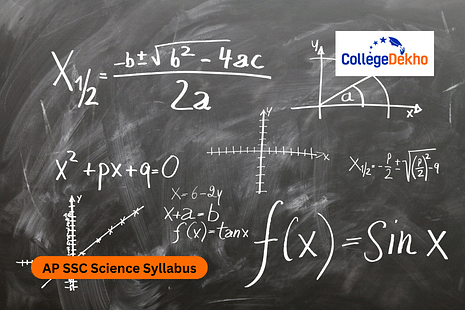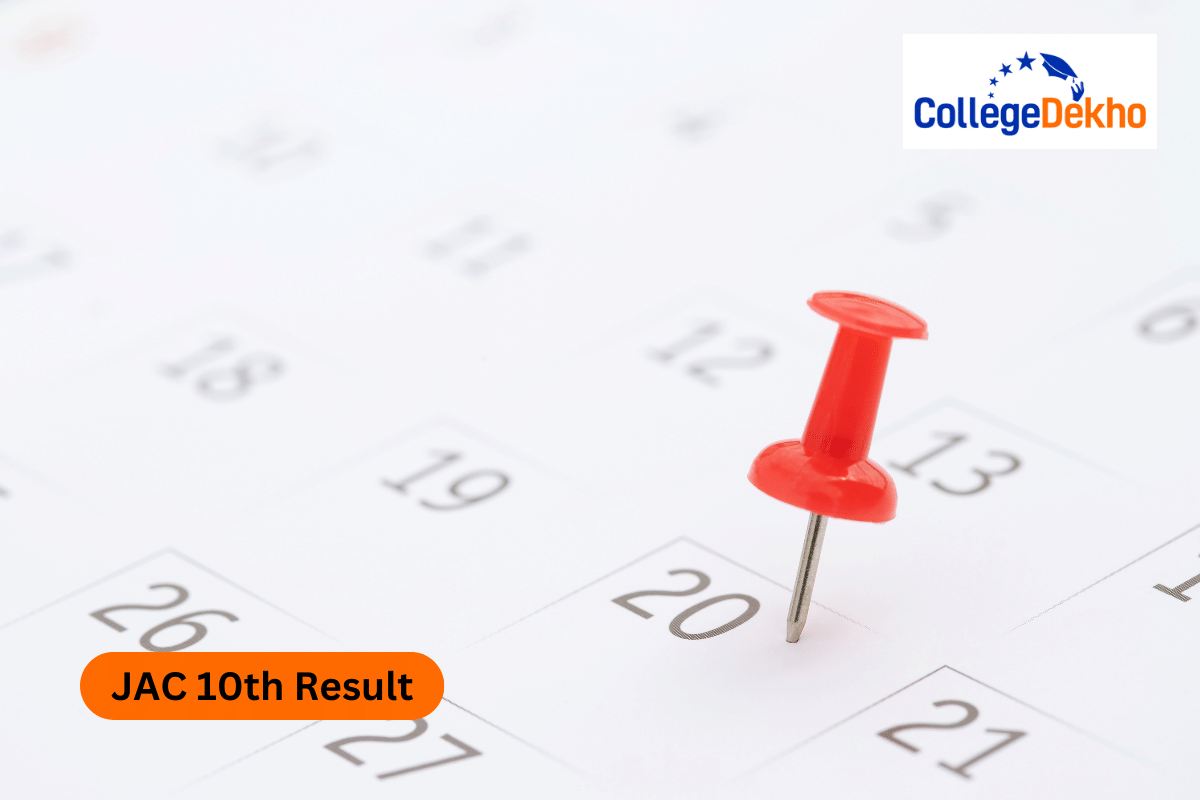

Never Miss an Exam Update
About AP SSC Science Syllabus 2025
The Board of Secondary Education Andhra Pradesh will list the official syllabus on the website to be downloaded by the students. Students are required to download the detailed syllabus to start the preparations for the exams. Two papers will be conducted for Science, one for physical science and one for biological science. Each paper will be conducted for 50 marks. The question paper will have a variety of questions ranging from MCQs and long answer type questions. The maximum mark allotted for the Science theory paper will be 100. Students will be allowed 3 hours to complete the question paper and 15 minutes will be given by the board authorities to read the question paper. Students will have to score at least 35% marks out of 100 to successfully pass the board exams. Check out more information about the detailed AP SSC Science Syllabus 2025 from the details given below:
Latest Update:
- March 13, 2025: The Board of Secondary Education, Andhra Pradesh will conduct the AP SSC exam 2025 from March 17 to March 31, 2025, in pen and paper mode. The AP SSC hall tickets were issued on March 3, 2025, at bse.ap.gov.in.
Also Read: AP SSC Results 2025
AP SSC Science Syllabus 2025: Course Structure
Two papers will be conducted in Science for AP SSC students. Both the papers will be conducted for a total of 50 marks. Students can refer to the exam pattern for the same from the tables given below:
Paper 1
Sections | AS 1 | AS 2 | AS 3 | AS 4 | AS 5 | AS 6 | Total Questions | Total Marks |
|---|---|---|---|---|---|---|---|---|
Section 1- One mark question | 2 | 1 | - | 3 | 1 | 1 | 8 | 8 |
Section 2- Two marks question | 1 | 2 | - | - | - | - | 3 | 6 |
Section 3- Four marks question | - | - | - | 1 | 1 | 1 | 3 | 12 |
Section 4- Eight marks question | 1 | - | 1 | - | - | - | 2 | 24 |
Total | 4 | 3 | 1 | 4 | 2 | 2 | 17 | 50 |
Paper 2
Sections | AS 1 | AS 2 | AS 3 | AS 4 | AS 5 | AS 6 | Total Questions | Total Marks |
|---|---|---|---|---|---|---|---|---|
Section 1- One mark question | 2 | 1 | - | 1 | 1 | 1 | 6 | 6 |
Section 2- Two marks question | 1 | 2 | - | 1 | - | - | 4 | 8 |
Section 3- Four marks question | 2 | - | - | 1 | 1+1 | 1 | 5 | 20 |
Section 4- Eight marks question | 1+1 | - | 1+1 | - | - | - | 2 | 16 |
Total | 6 | 3 | 1 | 3 | 2 | 2 | 17 | 50 |
Also Read: AP SSC Science Model Paper 2025
AP SSC Science Syllabus 2025: Units
Students must have detailed information about the chapters included in each unit of the curriculum. Check out the syllabus for the same from the table given below:
Physical Science
Unit | Sub - Topics |
|---|---|
|
Spherical mirrors, convex and concave mirrors Pole, Focus, Centre of curvature, principle axis, Radius of curvature, Focal length Formula for spherical mirrors – sign convention Application of reflection – Solar Cooker, etc. |
|
Chemical equations – writing chemical equations, skeletal chemical equations, balancing chemical equations Writing symbols of physical states, Heat changes, gas evolved and precipitate formed Interpreting a balanced chemical equation |
|
What do acids have in common? What do bases have in common? Do Acids produce Ions only in Aqueous Solution? Reaction of Acid, Base with water Strength of Acid or Base – pH scale Importance of pH in everyday life Salts Chemicals from common salt |
|
Lenses Rules for Ray diagram Images formed by the lenses Formula derived for thin lenses Focal length of lens depends on the surrounding medium Lens maker formula |
5. Human eye and colourful world |
Structure of human Eye – Focal length of human Eye lens, accommodation Common accommodation defects of vision – Myopia, Hypermetropia, presbyopia Prism Scattering of light |
6. Structure of atom |
Electromagnetic Spectrum Bohr’s model of a Hydrogen atom and its limitations Quantum mechanical model of an Atom Electronic Configuration of elements in their atoms nl rule, Energies of electronic energy levels (n+l) rule; Aufbau Principle, Pauli’s principle, Hund’s Rule of maximum multiplicity, Stable configurations |
7. Classification of Elements – The Periodic Table |
Doberieners Triads – Limitations Newland’s law of Octaves Mendeleev’s Periodic Table (Periodic law, Achievements & Limitations) Modern Periodic Table. |
8. Chemical Bonding |
Electronic theory of Valence by Lewis and Kossel Ionic and Covalent bonds: examples with Lewis Dot formulae The arrangement of Ions in Ionic compounds Factors affecting the formation of cation and anion Shapes, bond lengths and bond energies in molecules Valence shell electron pair repulsion theory Valence bond theory Properties of Ionic and Covalent Compounds |
9. Electric Current |
Potential difference How a battery or a cell works Ohm's law and its limitations, resistance, specific resistance, factors influencing resistance, electric shock Electric Circuits Electric power Safety fuses |
10. Electromagnetism |
Magnetic field – field lines Magnetic field due to currents Magnetic force on moving charge and current carrying wire Electric motor Electromagnetic induction – Faraday’s law (including magnetic flux) – Lenz law Generators and Alternating – Direct Currents |
11. Principles of Metallurgy |
Extraction of metals from the Ores – activity series and related metallurgy, flow chart of steps involved in the extraction of metals from ore. Corrosion – Prevention of Corrosion Important Processes used in metallurgy Flux Furnace |
12. Carbon and its compounds | Introduction of Carbon compounds Promotion of an Electron – Bonding in Carbon including Hybridization Allotropes of Carbon Versatile nature of carbon Hydrocarbons Bonding of carbon with other elements Isomerism Homologous series Nomenclature of carbon compounds Chemical properties of carbon compounds Important carbon compounds Esterification reactions Soaps – Saponification, Micelles |
Biological Science
Units | Chapters |
|---|---|
Nutrition | Life process- Introduction Photosynthesis Nutrition in organisms Digestion in human beings Healthy points about oesophagus Malnutrition |
Respiration |
Respiratory system in human being Cellular respiration Respiration – Combustion Evolution of gaseous exchange Plant respiration |
Transportation |
Cardiac cycle Lymphatic system Evolution of transport system Blood pressure Blood clotting Transportation in plants |
Excretion | Excretion in Human beings Excretory system Structure of Nephron Formation of urine Dialysis – Artificial kidney Accessory Excretory organs in human being (Lungs, skin, liver, large intestine) Excretion in other organisms Excretion in plants Excretion, Secretion |
Coordination | Stimulus and response Integrated system – Nerves coordination Nerve cell structure Pathways from stimulus to response Reflex arc Central nervous system Peripheral nervous system Coordination without nerves Autonomous nervous system Coordination in plants – Phytohormones |
Reproduction | Growth of bacteria in milk. Asexual reproduction Sexual reproduction Sexual reproduction in plants Cell division – Cell cycle Reproductive health – HIV/ AIDS |
Coordination in Life Processes | Hunger Relation between taste and smell Mouth – a mastication machine Passage of food through oesophagus Stomach is mixer |
Heredity and Evolution | New Characters – variation Experiments conducted by Mendal (F1 generation,F2 generation), Mendel’s Laws Parents to offsprings Evolution Origin of species Evolution – Evidences Human Evolution |
Our Environment | Ecosystem – Food chain Human activities – Their effect on ecosystem Biological pest control measures |
Natural resources | Case study – Agricultural land (past and present) Case study – Water management Water resources in the Telugu States Natural resources around us Forest Renewable resources Fossil fuels Conservation, Reduce, Reuse, Recycle, Recover |
Also Read: AP SSC Science Previous Year Question Paper
AP SSC Science Question Paper Design 2025
Students can refer to the following question paper design that will be followed by the Board of Secondary Education Andhra Pradesh to construct both question papers in this subject:
- The duration of each paper will be two hours and 15 minutes.
- The maximum mark allotted for each paper will be 50.
- Each paper will be divided into four sections.
- The question paper will have a total of 17 questions.
- Internal choices will be present in certain sections of the question paper.
AP SSC Science Books 2025
After completing your NCERT or books recommended by your teachers, the students can refer to the following side books to prepare well for the exams:
- All In One Class 10th Science For Cbse Exam 2025
- Vigyan Textbook Science for Class - 10 - 1065
- Arihant All In One Science Cbse Class 10th
- Xam Idea Science CBSE Class 10
- PW CBSE Question Bank Class 10 Science
Preparing For AP SSC Science Exam 2025
Students can follow the following tips and tricks to score good marks in the exam:
- Make a study plan and follow it thoroughly during the academic year to complete your syllabus on time.
- For subjects like Science, it is very beneficial to learn through YouTube and to understand concepts creatively.
- Make sure to draw and practice diagrams wherever necessary.
- Try and solve sample papers available online for a quick revision.
- Make notes after the end of every lecture to revise for the exam easily.
AP SSC Exam 2025: Verification of Marks
The Board of Secondary Education, Andhra Pradesh (BSEAP), offers a mark verification facility for students under the following conditions:
- Re-verification is available for three language papers, Mathematics, and General Science.
- The process includes retotaling and recounting of marks but does not involve revaluation. Only answers awarded zero marks will be reconsidered.
- Students dissatisfied with their scores can apply for re-verification by paying a fee of ₹1000 per subject through Challan.
- Applicants must submit a Xerox copy of their hall ticket, a dummy marks memo, and a self-addressed 12 x 9 envelope with the principal’s address along with the application form.
Make sure to refer to the latest AP SSC Science Syllabus 2025 when starting your preparation for the exam. Try to solve as many question papers as necessary for an effective revision at the end of the preparation.
FAQs
To complete the AP SSC Science Syllabus 2024-25 on time, try to give equal importance to each section and allot equal study slots to all of them. Try to focus on completing the syllabus in the first few months of your preparations and revise in the last few once.
AP SSC Science Syllabus 2024-25 is not yet available on the official website of the Board of Secondary Education, Andhra Pradesh.
Was this article helpful?















